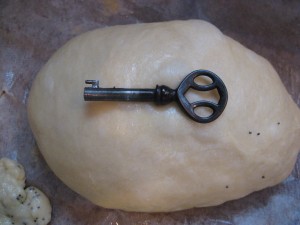The Key is in the Dough
By Sara Esther Crispe: April 24, 2014: Category Decoding the Tradition, Inspirations
 Have you ever locked yourself out of your house? Your car? It is quite embarrassing if not downright debilitating. After all, it doesn’t matter where you live or what you drive, if you lose or lose sight of that one little piece of metal, the key to your entrance, there is simply no easy way in.
Have you ever locked yourself out of your house? Your car? It is quite embarrassing if not downright debilitating. After all, it doesn’t matter where you live or what you drive, if you lose or lose sight of that one little piece of metal, the key to your entrance, there is simply no easy way in.
It’s kind of funny that all it takes to enter into something so powerful, so big, so strong is something so small and seemingly insignificant. And not just any key will do, but it has to be the right key. The one that fits. The one was created for exactly where we want to enter.
Every year, the Shabbat following Passover, there is a tradition called shissel challah in which the challah is either formed in the shape of a key or a key is literally baked within the challah. The idea stems from a verse in the Talmud that the Creator holds the key to one’s physical sustenance. Thus, if one wants to tap into more of what is hopefully in store, the key must be found and revealed.
But why the connection to challah? Challah is often thought of as the delicious bread eaten on Shabbat. But it isn’t. It is actually the piece of bread that is specifically not eaten. Challah is the small piece that was separated in the preparation of that bread. The piece that serves as a reminder that ultimately the bread in one’s life is a gift. And gifts should be acknowledged and thanked. Thus, the concept of separating a piece of dough, before it is even made into a final product, is to give back in gratitude and awareness for the gift that is about to come.
Even in English money is referred to as “bread” or even “dough.” Bread is different than other foods in Jewish tradition and has a special status for which an extensive blessing is recited after eating it. There is also the custom that bread is not to be thrown out. Since it represents financial success the idea is not to be flippant with it. If there are uneaten pieces they are to be respected. Therefore there is a custom to give them to the birds or have them wrapped before they are disposed. This way nothing is wasted as the message is that nothing should ever be wasted.
Bread has another unique quality to it as well. The dough rises in the process of its making. It represents the ego. After all, this is one of the reasons it is specifically not eaten on Passover when only unleavened bread is consumed. Flat bread. Poor man’s bread. Matzah is referred to as the bread of affliction, yet also the bread of faith and the bread of freedom. They seem so contradictory and yet they couldn’t be more related.
Sometimes it is only when one has been stripped of what he has and who he is that he starts to realize what he needs to do. So many are enslaved and don’t even recognize it. And often we can be in bondage because of the very things we like to associate with our freedom. Our ego, our money, our success, our status can actually imprison us.
The faith is believing that our situation can changed and that we can break out of our slavery. And when we can recognize that we were not free, then when we are, we can appreciate what freedom is. So the matzah therefore ties affliction to faith and to freedom.
Yet it is easy to forget. Once Passover is over and “regular” life resumes—leavened bread and all—one could lose track of what really counts and fall back into the same traps as before. So it is the week following Passover that the key in the challah is observed. The message is that we should enjoy all we have in life. And we should have the right balance of ego to recognize our strengths and abilities. But we can never forget what the true key is to all we have and all we are capable of. The key is hidden within the dough. Within the ego, within our financial abilities, within our material success there is a key. It is small, it could be overlooked, but it is the most essential part.
If we are going to tap into our true abilities, if we are going to grow and develop and reach new heights, we need that key. That key is essential to turn the lock and let us in. But we must remember that while we may be fortunate to use the key, we are not the key. It is only on loan to us. And the more we use it to open doors not only for ourselves but for those around us, the longer it will hopefully stay in our possession.
The Key is in the Dough,













;)
;)
;)
;)
;)
;)
;)
;)
;)
;)

This is terrific! Thank you for the clear, concise and creative manner you expressed these deep thoughts ! Good Shabbos. Btw…I want to rate this article with a 5+ rating but the glitch would not allow it !